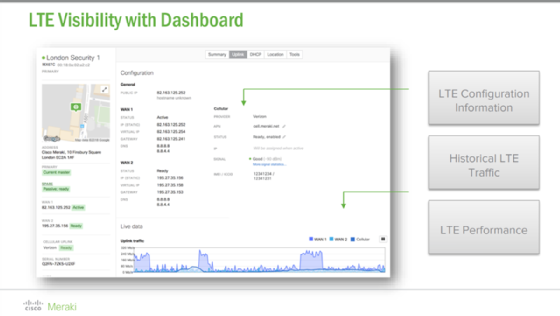
Fotolia
Cisco adds LTE modem to Meraki MX security appliance
Cisco adds a built-in 4G wireless broadband modem to two Meraki MX security appliances. Cisco launched the Meraki MX67C and the MX68CW devices with an integrated CAT 6 LTE cellular modem. The company also introduced four faster MX models without LTE.
Cisco has introduced Meraki MX security appliances with a built-in 4G wireless broadband modem. The company also added the Long Term Evolution, or LTE, modem to a new Z-series teleworker gateway.
This week, Cisco launched the Meraki MX67C and MX68CW with an integrated CAT 6 LTE cellular modem. Also, Cisco unveiled four MX models – the MX67, MX68, MX67W and MX68W -- without LTE but with more throughput than older models. All the new MX hardware, which are the first in the Meraki line to support the 802.11ac Wave 2 Wi-Fi standard, can deliver up to 450 Mbps of firewall throughput.
Network admins manage Cisco Meraki switches, appliances and access points through a web-based console called the Meraki Dashboard, which also provides automation and analytics. Cisco has aimed the product line at small branch offices and retailers that need a no-frills wireless LAN. For an access layer that meets the need of larger enterprises, Cisco offers the Aironet APs and Catalyst switches.
MX appliances are unified threat management devices with software-defined WAN functionality. A UTM system combines and integrates multiple security services and features, including a firewall.
Uses for LTE in the Meraki MX
The higher throughput in the latest MX appliances is aimed at companies accessing SaaS applications, such as Microsoft Office 365, said Imran Idrees, a marketing manager in Cisco's Meraki unit. Remote branch offices can use the LTE modem as a substitute for broadband when it isn't available.
Companies could also use the LTE connection as a failover link, Idrees said. If the Ethernet connection goes down, then the MX would switch to LTE.
"Given the ubiquity and increasing performance of LTE, this is a relatively inexpensive way for a branch office to increase its network availability," said Mark Hung, an analyst at Gartner.
The cellular MX models have one Nano SIM card slot for connecting to a carrier's LTE network. The built-in modem makes it possible track usage and performance of the MX from the Meraki Dashboard.
Getting LTE on older Meraki MX models required companies to plug a carrier-provided USB stick that contained the 4G modem. Because the modem wasn't integrated with the MX, no data was captured for tracking performance.
With the latest models, data captured from the LTE connection includes signal strength, the provider's name and how much data is traveling over the link. All the information is displayed on the Meraki Dashboard.

The Z3C gateway
The Z3C teleworker gateway is for workers who need a secure connection to the corporate network while they are on the road. "It's a very compact device that a business person would take around with them," Idrees said.
The previous version of the gateway, Z3, required a traveler to plug a hotel room's Ethernet cable into the device to gain access to the corporate network. The Z3C has the option of connecting over LTE.
Companies that want to use a Meraki WLAN have to purchase the product line's devices and a cloud subscription license. Once the license is registered, network managers can configure and manage the hardware through the Meraki Dashboard.






